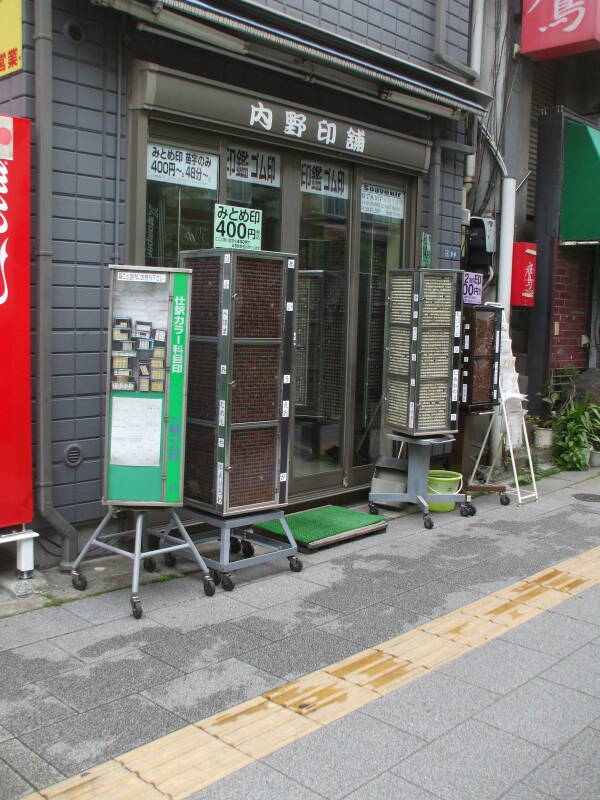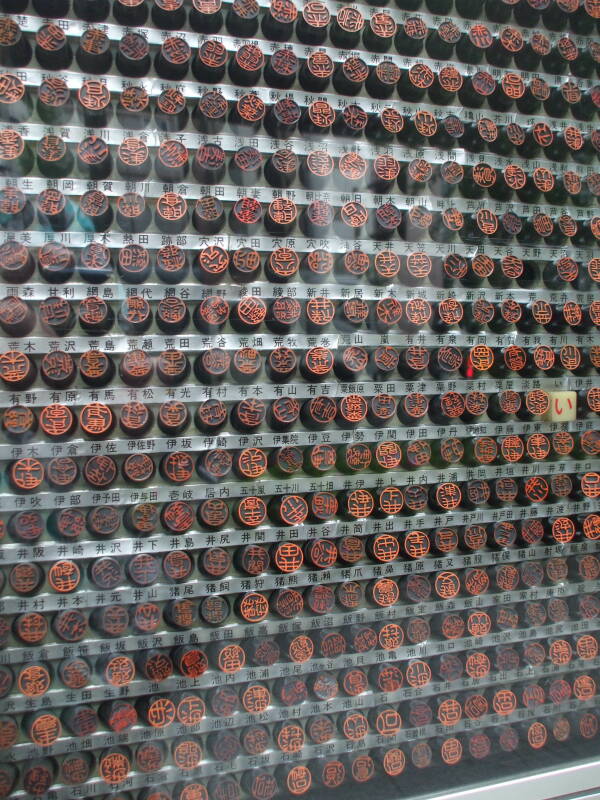
Personal Seals
Inkan and Hanko Personal Seals
Personal and corporate seals are used to finalize a
wide range of business transactions in Japan.
The idea of using a hand stamp on a document originated
in China, and spread through eastern Asia.
Inkan
or 印鑑
is the most general term,
hanko
or 判子
are the low-cost stamps
used for less critical or formal events.
Just in or 印
refers to the imprint the stamp makes.
Here's a shop selling
みとめ印
or
mitome-in,
inexpensive premanufactured seals,
for 400 円
or 400 yen.
These are only moderately formal seals, used for
events like signing for deliveries and authenticating
utility payments.
Assuming you have a common Japanese name, or want a
popular kanji or pictoral glyph.
Since my most recent visit to Japan, I have learned
that the Don Quixote chain and other 100-yen shops
have machines on which you can make your own seals!

Types of Seals
One way of categorizing seals is by what they denote.
A name seal prints the owner's name, typically as family name followed by given name. There's no way the 100-yen shop or even a classier joint like the one shown above will have "Cromwell Bob" just sitting on the shelf.
Katakana &Hiragana
I would need コロモヱル ボブ for koromoweru bobu spelled phonetically in katakana, used to spell foreign words, or ころもゑる ぼぶ for the hiragana version.
A free seal can be anything, perhaps just a picture of an animal, to express the owner's personality.
Studio seals have been used by artists and writers. One specific variety of these is the alias seal, showing artistic pseudonyms and pen names. If I were stamping papers during professional travel, I could use トイレ グル or といれ ぐる for toire guru.
Another way to distinguish seals is by their printing pattern. Shubun or "Red Character" seals print the glyphs in the vermillion red ink paste, with a white unprinted background:
グル
Hakubun or "White Character" seals are the other way around:
ぐる

Seals Arrive in Japan
VisitingFukuoka
In 57 CE Emperor Guangwu of Han gave a large seal made from solid gold to the ruler of Nakoku, the area around today's Fukuoka in northern Kyūshū. The Chinese glyphs on the seal identify it as belonging to the King of Na of the State of Wa, a vassal state of the Han Dynasty. Emperor Guangwu gave the seal to a diplomatic official visiting from Japan.
For the next few centuries in Japan, only the Emperor and his most trusted advisors had seals, symbolizing the Emperor's authority.
After about 750 CE the nobility began using personal seals. The samurai began using seals during the Feudal Period of 1185–1603, when the Emperor was largely a figurehead but a single Shōgun or top warlord had not yet seized unified control of Japan.
After the Emperor overthrew the Shōgun and returned to power in the Meiji Restoration, starting in 1868, the common people began using seals.
Using Seals in Japan
A jitsuin is an officially registered seal, used for business and legally binding transactions like property purchases, marriage, and vehicle purchases. Their form is carefully specified by local law. Since a jitsuin is both necessary and sufficient for major business and personal transactions, it must be carefully protected. Locked in a safe deposit box at a bank, or in a safe at a business, or else very carefully hidden at a home.
If you're going to do a significant business transaction, you must use a jitsuin seal that can be authenticated as the seal registered with the local authorities. First, you must take your seal to the city hall and have an impression with your seal certified.
A ginkō-in is a seal specifically for banking, it's name literally means "bank seal". Its form is specified by the bank. The owner would probably keep them at home, carefully hidden, but not as carefully hidden as a jitsuin. Of course, Japan has very little crime — carefully hidden at home in Japan means it's pretty safe.
A mitome-in is the next step toward informality. My pictures above are of a small shop selling みとめ印 or mitome-in. They're used for medium to low security everyday use. You could use one of these to sign for a delivery or authorize a utility payment. They would likely be stored in a desk drawer, or a drawer in a cabinet near the front door.
A hanko is far less formal. They're often a single kanji ideograph, or a single katakana or hiragana glyph representing a single consonant-vowel syllable.
The End of Seals?
There is concern that modern technology is making hanko fraud easier. 3-D printing will be the end of the ancient Chinese authentication technology.
Also, while the use of seals had already been slowing down business transactions, it became a bigger problem with the COVID-19 pandemic. The national government found that the use of seals was slowing down communication to the point that discovering, documenting, and announcing a COVID-19 case to the public was taking up to three days. Japan's Prime Minister Yoshihide Suga soon declared that there was a new national priority for digitizing government bureaucracy, and all of Japanese society after that.
Better Than Hand Signatures
When I first heard of hanko and other in systems, it was very different from what I was used to. I was skeptical.
Much later I thought about the hand signature system I'm used to in the U.S. How could a bank verify that a signature is really mine? I have poor handwriting. I hadn't needed to write anything in cursive script since some Russian courses, but then I had to take over some business details for my parents.
I can't sign my name the same way twice in a row. If someone insists that I must fill in all the fields of a check in cursive script, five minutes later I can't decipher what I wrote.
If I can't consistently sign my name, any attempt to authenticate me will suffer from a very high rate of false negative errors. It's really me, but I can't do a "correct" signature.
Meanwhile, anyone halfway skilled could forge something that would be accepted as my erratic signature. They could scrawl something that's close enough for a false positive error. It isn't me, but it seems to be.
Digital Signatures Could Work, If Done Correctly
From time to time someone asks me to sign a form for them. Maybe they have passed a certification exam and the certifying organization wants someone to vouch for them.
OK, fine, what should I do, print this out, sign it, and sent it to you through the postal service?
Oh no, digitally sign it!
OK, I have PGP software, GnuPG. I suppose I could use that, but you'll need to have a trusted copy of my public key, and...
Oh no, what are you talking about? Just read it into Adobe Reader and digitally sign it with that!
How to create and verify digital certificatesWow, apparently meaningful authentication is not an important goal here.
But OK, fine, I'll power up a Windows system. Adobe quit making their Reader software for Linux several years ago. However, on Windows I can install Adobe Reader and make a self-signed certificate that means exactly nothing.
The Man Who Would Have Been The Ottoman SultanErtuğrul Osman V, also known as Devletli Necabetli Ertuğrul Osman Efendi Hazretleri, was born in 1912. He was in line for the Ottoman throne and was in school in Vienna when Sultan Mehmed VI, the last Ottoman Sultan, was deposed in November 1922. The House of Osman had ruled Turkey and its possessions since 1281.
Ertuğrul moved to the US in 1933, and to Manhattan in 1939. He ran a mining company, Wells Overseas, and frequently traveled to South America to oversee its operation. In place of a passport he used a certificate devised by his lawyer and which he issued to himself as a passport while acting in the name of the no longer existant Ottoman Empire. He traveled internationally on the passport he had issued to himself until regulations were tightened after September, 2001.
The above is specific to travel logistics. Maybe you're looking for information on specific places in Japan.



































